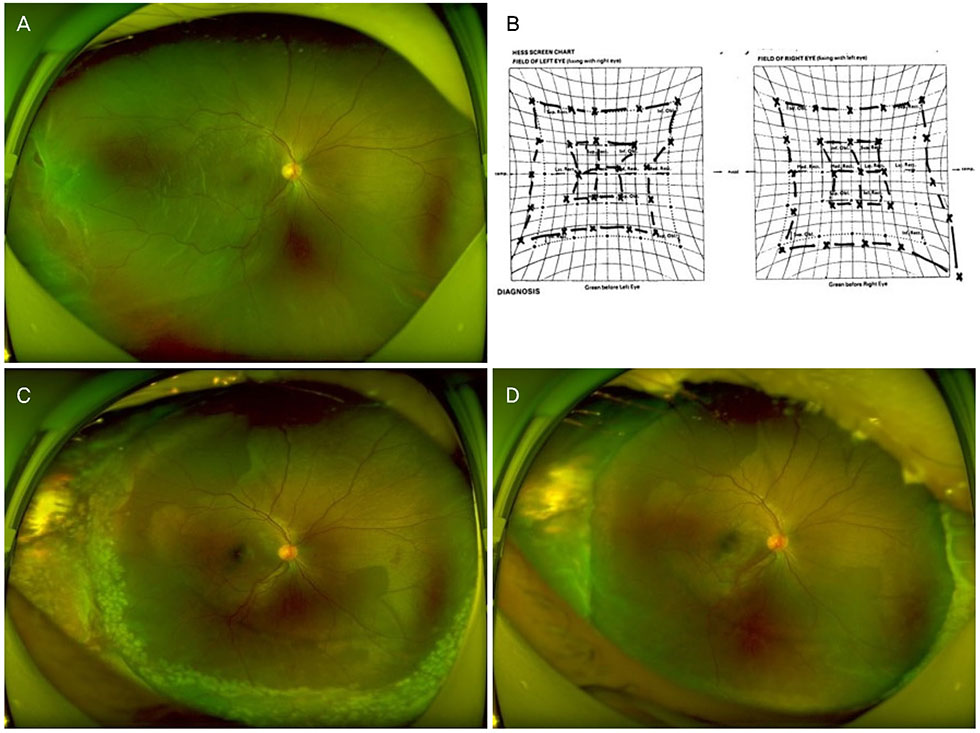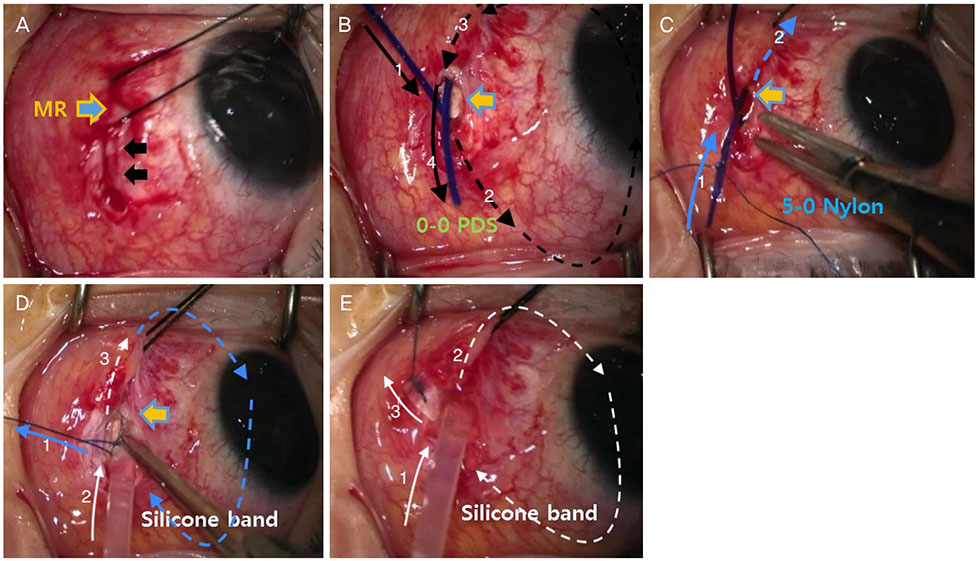J Korean Ophthalmol Soc.
2019 Jul;60(7):696-700. 10.3341/jkos.2019.60.7.696.
Utilizing a Previous Silicone Band Track in Recurred Retinal Detachment
- Affiliations
-
- 1Department of Ophthalmology, Soonchunhyang University Bucheon Hospital, Soonchunhyang University College of Medicine, Bucheon, Korea.
- 2Department of Ophthalmology, Soonchunhyang University Seoul Hospital, Soonchunhyang University College of Medicine, Seoul, Korea. ckseek@schmc.ac.kr
- KMID: 2453022
- DOI: http://doi.org/10.3341/jkos.2019.60.7.696
Abstract
- PURPOSE
We report a case of utilizing a previous silicone band track in the reoperation of scleral encircling.
CASE SUMMARY
An 8-year-old male presented with rhegmatogenous retinal detachment in the right eye. Five days after this diagnosis, he received scleral buckling surgery and cryopexy to seal the retinal tear. One month after surgery, a fundus examination showed subretinal fluid at the inferior site of the scleral buckle. He underwent scleral encircling surgery and a cryopexy procedure. The patient has had an uneventful postoperative course, and the retina has remained attached over a follow-up period of 9 months. However, exotropia and hypotropia developed in the right eye. Diagnosis of restrictive strabismus due to tissue adhesion around the silicone band was made. The encircling band was therefore removed and laser photocoagulation was performed 360° around the retina. Twenty-four hours after surgery, a fundus examination showed subretinal fluid. He received 360° scleral encircling surgery not using the 360° conjunctival peritomy. After confirming a previous encircling tract using #0-0 polydioxanone as a guide, #5-0 Nylon was tied to the end of the guide and inserted through the encircling tract with the end sutured with the silicone band. The silicone band was inserted into the encircling tract by pulling the #5-0 Nylon as a guide. Ophthalmoscopy revealed an attached retina with indentation of the scleral buckle at 360°.
CONCLUSIONS
For reoperation in patients who previously underwent scleral encircling surgery, using the previous scleral encircling tract may be effective in cases with conjunctival and tissue adhesion.
MeSH Terms
Figure
Reference
-
1. Shunmugam M, Shah AN, Hysi PG, Williamson TH. The pattern and distribution of retinal breaks in eyes with rhegmatogenous retinal detachment. Am J Ophthalmol. 2014; 157:221–226.e1.
Article2. Gonin J. The treatment of detached retina by searing the retinal tears. Arch Ophthalmol. 1930; 4:621–625.
Article3. Schepens CL. Symposium: present status of retinal detachment surgery. Scleral buckling with circling element. Trans Am Acad Ophthalmol Otolaryngol. 1964; 68:959–979.4. Lincoff HA, Baras I, McLean J. Modifications to the custodis procedure for retinal detachment. Arch Ophthalmol. 1965; 73:160–163.
Article5. D'Amico DJ. Clinical practice. Primary retinal detachment. N Engl J Med. 2008; 359:2346–2354.6. Greven CM, Wall AB, Slusher MM. Anatomic and visual results in asymptomatic clinical rhegmatogenous retinal detachment repaired by scleral buckling. Am J Ophthalmol. 1999; 128:618–620.
Article7. Yao Y, Jiang L, Wang ZJ, Zhang MN. Scleral buckling procedures for longstanding or chronic rhegmatogenous retinal detachment with subretinal proliferation. Ophthalmology. 2006; 113:821–825.
Article8. Tsui I. Scleral buckle removal: indications and outcomes. Surv Ophthalmol. 2012; 57:253–263.
Article9. Kreiger AE, Hodgkinson BJ, Frederick AR Jr, Smith TR. The results of retinal detachment surgery. Analysis of 268 operations with a broad scleral buckle. Arch Ophthalmol. 1971; 86:385–394.10. Kanski JJ, Elkington AR, Davies MS. Diplopia after retinal detachment surgery. Am J Ophthalmol. 1973; 76:38–40.
Article11. Sewell JJ, Knobloch WH, Eifrig DE. Extraocular muscle imbalance after surgical treatment for retinal detachment. Am J Ophthalmol. 1974; 78:321–323.
Article12. Wolff SM. Strabismus after retinal detachment surgery. Trans Am Ophthalmol Soc. 1983; 81:182–192.13. Saleh TA, Gray RH. New retinal detachment following removal of a scleral explant. Eye (Lond). 2003; 17:245–246.
Article14. Foster RE, Meyers SM. Recurrent retinal detachment more than 1 year after reattachment. Ophthalmology. 2002; 109:1821–1827.
Article
- Full Text Links
- Actions
-
Cited
- CITED
-
- Close
- Share
- Similar articles
-
- A Case of Silicone Band Migration Following an Encircling Procedure
- The Retinal Detachment Surgery Utilizing Human Tissue: II. Sling Technique
- A Case of Hyperoleon
- A Clinical Study of Retinal Detachment Following Intraocular Silicone Oil Removal
- The Management of Giant Retinal Tear by use of Perfluorodecalin(DK-line(R) and Silicone Oil



